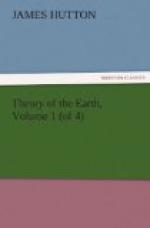We are not now inquiring how an inferior stratum should have been heated in a lesser degree, or not consolidated, while a superior stratum had been consolidated in the most perfect manner; we are to reason upon a fact, which is, that the horizontal strata in general appear not to have been equally or universally consolidated; and this we must attribute to an insufficient exertion of the consolidating cause. But, so far as the erecting cause is considered as the same with that by which the elevated bodies were consolidated, and so far as the vertical situation is a proof of the great exertion of that subterraneous power, the strata which are most erected, should in general be found most consolidated.
Nothing more certain than that there have been several repeated operations of the mineralising power exerted upon the strata in particular places; and all those mineral operations tend to consolidation: Therefore, the more the operations have been repeated in any place, the more we should find the strata consolidated, or changed from their natural state. Vertical strata have every appearance from whence we should be led to conclude, that much of the mineral power had been exerted upon them, in changing their original constitution or appearance. But the question now to be considered is this, How far it may appear that these masses of matter, which now seem to be so different from the ordinary strata of the globe, had been twice subjected to the mineral operations, in having been first consolidated and erected into the place of land, and afterwards sunk below the bottom of the sea, in order a second time to undergo the process of subterraneous heat, and again be elevated into the place where they now are found.
It must be evident, here is a question that may not be easy to decide. It is not to the degree of any change to which bodies may be subject, that we are to appeal, in order to clear up the point in question, but to a regular course of operations, which must appear to have been successively transacted, and by which the different circumstances or situations of those masses are to be discovered in their present state. Now, though it does not concern the present theory that this question be decided, as it is nothing but a repetition of the same operations that we look for; nevertheless, it would be an interesting fact in the natural history of this earth; and it would add great lustre to a theory by which so great, so many operations were to be explained. I am far from being sanguine in my expectations of giving all the satisfaction in relation to this subject that I could wish; but it will be proper to state what I have lately learned with regard to so curious a question, that others, who shall have the opportunity, may be led to inquire, and that thus the natural history of the earth may be enlarged, by a proper investigation of its mineral operations.




